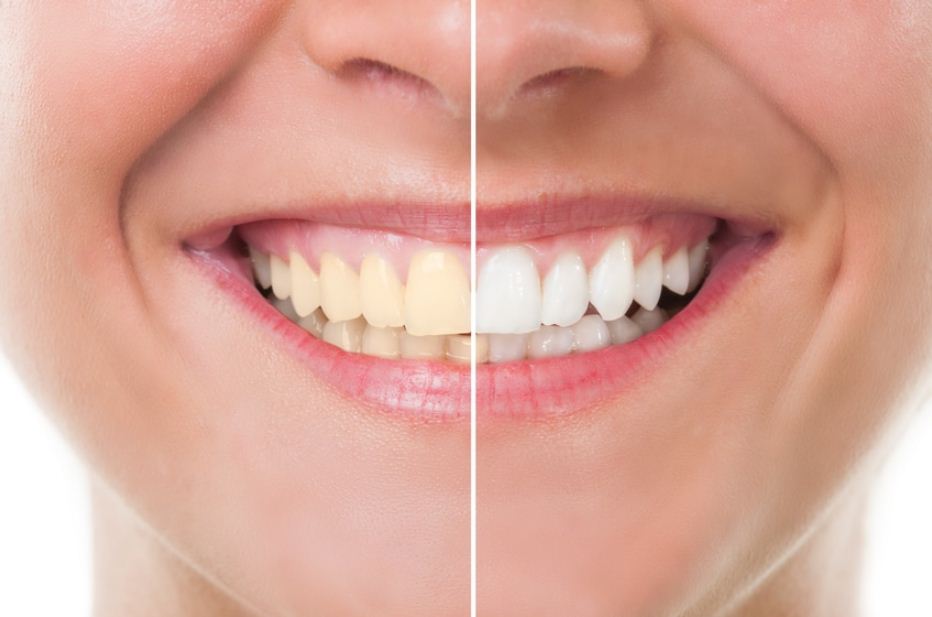They say the quickest way to look 40% better is by whitening your teeth. Dental bleaching is a highly effective cosmetic procedure that not only makes your teeth whiter but also boosts your confidence, helping you stand taller and prouder.
Dental bleaching is generally very safe, especially when done correctly, as it typically affects only the outer layer of your tooth—the enamel. The key ingredient in most whitening treatments is hydrogen peroxide. This small molecule can penetrate the enamel and reach the underlying layer of the tooth, called the dentin. Once there, it begins to break down deeper stains that have settled into the tooth over time.
Teeth stains are often caused by organic compounds known as chromogens (pigmented molecules). These compounds get absorbed into the porous enamel and dentin. When hydrogen peroxide comes into contact with these stains, it breaks down the long chains of the chromogens into smaller, colorless molecules, making the stains less visible. As hydrogen peroxide decomposes, it releases free radicals (reactive oxygen species), which speed up the process of whitening by lifting the discoloration and restoring your teeth’s natural brightness.
What Role Does Light Play in Whitening?
You may have heard that light can help speed up the whitening process. But is this true?
The light used in dental clinics is said to activate the hydrogen peroxide, making it work faster and more effectively. Studies have shown that light can indeed help accelerate the breakdown of hydrogen peroxide, but the question remains—does it really make a significant difference in the results?
Several studies have investigated this. For example:
Efficacy of Tooth Bleaching with and Without Light Activation and Its Effect on the Pulp Temperature: An In Vitro Study (2012)
Effectiveness of Light Sources on In-Office Dental Bleaching: A Systematic Review
Evaluation of Light Activation on In-office Dental Bleaching: A Systematic Review
These studies compared in-office bleaching using only chemical whitening with 38% hydrogen peroxide for 4 rounds (15 minutes each), as well as bleaching combined with halogen, LED, or laser light activation. They looked at the color change immediately after bleaching, 1 day later, and 1 and 3 months after treatment.
The results showed that the halogen light produced the greatest color change after 3 months, followed by chemical whitening alone, then LED light, and finally, laser light. So, does halogen light make a noticeable difference? Not necessarily. While halogen showed the biggest color change, it also caused a significant increase in the temperature of the pulp (the soft tissue inside the tooth).
Why Is Increased Pulp Temperature Bad?
Increased pulp temperature can be harmful because it can lead to tooth sensitivity or even damage to the tooth’s nerve. This is why chemical whitening, which does not raise the pulp temperature, is often considered a safer option. In fact, the studies mentioned earlier concluded that light activation did not show any additional advantages over chemical whitening. Although halogen light resulted in the most significant color change, it also caused a higher increase in pulp temperature, which could potentially lead to discomfort or other issues.
The Bottom Line
While light can help speed up the bleaching process, it doesn't always improve the results. In fact, chemical whitening alone is often just as effective and safer for your teeth. Always make sure your dentist uses the right technique for your needs to ensure both effective and safe results.
References
Efficacy of Tooth Bleaching with and Without Light Activation and Its Effect on the Pulp Temperature: An In Vitro Study (2012).
Journal of Endodontics. Available at: https://www.jendodon.com
(Accessed January 2025)
Effectiveness of Light Sources on In-Office Dental Bleaching: A Systematic Review.
Operative Dentistry Journal. Available at: https://meridian.allenpress.com
(Accessed January 2025)
Evaluation of Light Activation on In-office Dental Bleaching: A Systematic Review.
Journal of Dental Research. Available at: https://www.thejcdp.com
(Accessed January 2025)

